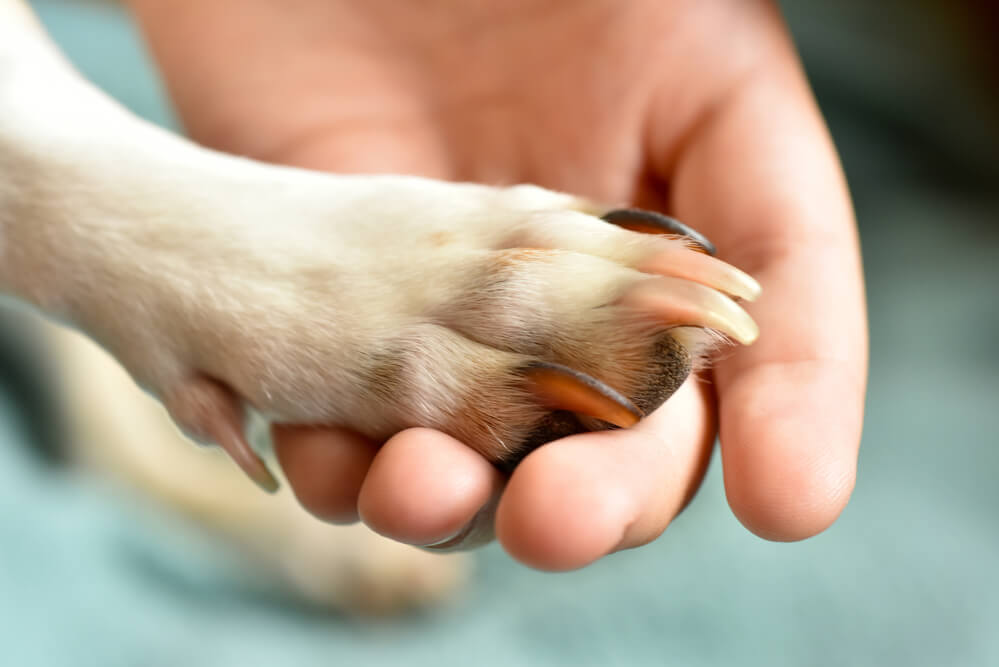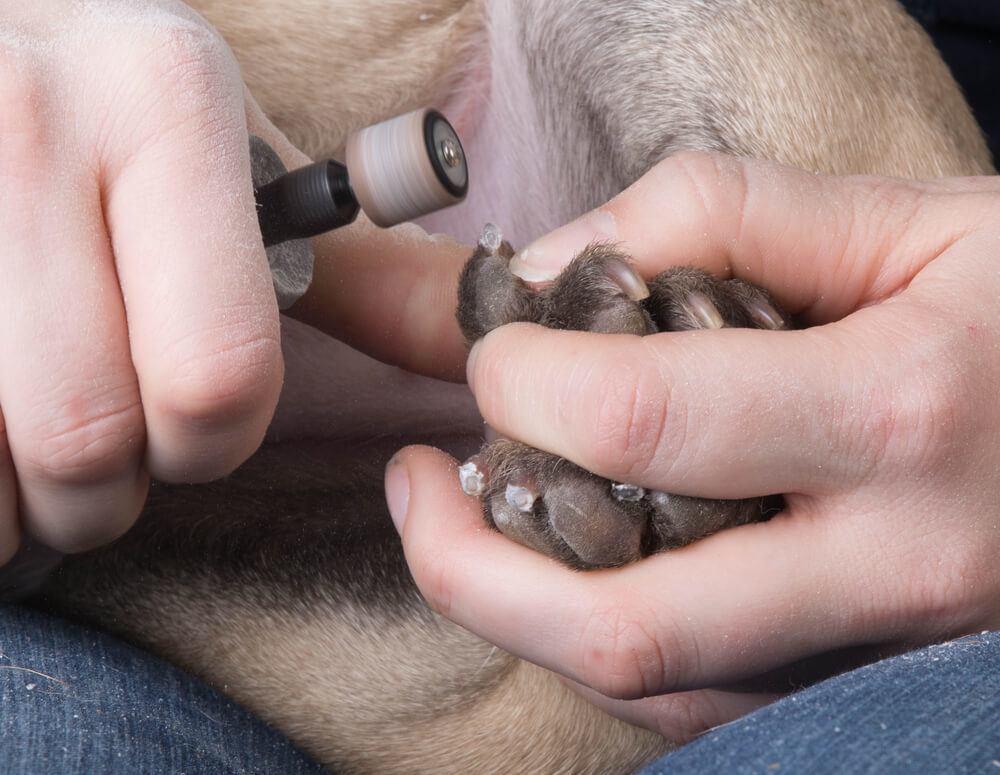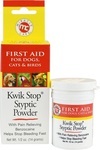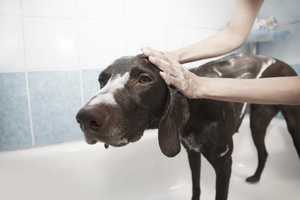This article has been medically reviewed by Dr. Chyrle Bonk, DVM.
As a caring pet parent, you’ll more than likely notice any changes in your pet. One of those changes can be the color of their toenails.
Noticing changes in your dog’s toenails may be important in identifying infections or changes that are secondary to an underlying disease.
In addition, proper maintenance with regular nail trims and the right nail clipping technique can help prevent common issues like hangnails and ingrown toenails.
Here you’ll learn how to handle black toenails in dogs and ways to prevent it.
Do dogs toenails change color?

Most of the time a change in nail is completely normal for dogs. It can happen with age. Other times a change in nail color may be a concern.
There are many types of paw and nail disorders that may lead to the discoloration of the nail. Causes range from mild to serious. Some require treatment but others do not.
Discoloration can happen with one or more toenails or even only affect a portion of the nail.
Important
Make it a habit to regularly check your dog's paws, and keep nails trimmed to prevent a number of problems.
Why are my dogs nails black?
There are many causes of nail discoloration in canines, ranging from simple to complex.
Genetics
Some dogs are genetically predisposed to having black toenails and this is perfectly normal. It just means they have more pigment in their toenails than dogs with lighter colored toenails.
Aging
Ageing can also lead to discoloration of a dog's toenails. That's because canine nails undergo changes over time, like growth rate, shape, thickness, texture and color. As your dog gets older, it's possible for the nails to gradually turn black.
Trauma
Untreated nail trauma caused by either excessive running on hard terrain like asphalt, concrete and gravel, or the improper use of nail clippers may cause a dog’s toenails to change.
"Injuries such as being smashed or crushed may also lead to blackened nails. This is similar to the bruising of finger and toenails that humans experience".
Dr. Chyrle Bonk, DVM
Infections
Black or brown nails could be as a result of a bacterial or fungal nail disease. In bacterial infections the most common inciting cause is trauma.
However infections of the nail bed could also be a sign of a systemic health condition such as hypothyroidism, diabetes or immune-mediated diseases and onychodystrophy among others.
In this case, a complete physical examination and consideration of systemic disease is essential.
Dirty environments may also play a role in nails turning black because of parasites and bacteria found especially in excessively wet or dry environments.
Excessive Licking
Excessive licking of the paws can also result in discoloration of the toenails, especially when the dog has an over-acidic system. This is just due to prolonged irritation to the nail bad. Dogs may over lick their paws as a result of allergies or behavioral issues.
Here is a summary of the most common reasons for abnormal discoloration in your dog's nail:
- Genetics/breed
- Exposure to the environment
- Injury/trauma
- Nail bed infection by bacteria or fungus
- Age
See Your Vet
If you suspect your has dog nail bed infection, contact your vet about starting treatment. There is the possibility that infections can spread if left untreated.
Symptoms of nail discoloration in dogs

You may be able to detect and prevent nail discoloration in dogs by recognizing the early symptoms. The most common being:
Pain When Walking
When a dog's feet or nails are sore, a dog may sit back on their paws to try to decrease the weight on their toes. They may also have difficulty walking.
So if you find your dog walking with difficulty or posing oddly, it might be a sign of infection.
Rashes or Redness of Skin Tissue
Any flakiness, redness, or swelling of the skin around a dog’s nails may be a sign of an underlying health problem. And neglecting it can lead to other complications like nail discoloration.
Deformed Nail Plates
This just means that toenails may develop lines, ridges, or lumps instead of a smooth texture. This can affect one or more nails depending on the severity or type of infection.
Paw Licking
Infections can be itchy and uncomfortable, causing a dog to lick. In severe cases, a dog may scratch its paws against the wall or floor, or even chew it.
Dogs lick parts of their body in an attempt to provide treatment for a wound as their saliva contains bacteria-killer and pain relieve elements.
But over-licking may do more harm than good when the problem is systemic, like kidney or heart diseases.
Use a properly-fitted Elizabethan collar for a guaranteed way to prevent paw-licking of an infection.
Smelly Nails and Pus
In severe conditions of an infection, a dog's toenails can start to smell and develop pus. Take him or her for an examination by a vet right away because neglect can lead to more serious conditions like pneumonia or bone diseases.
How to treat a dog's nail turning black?
The exact cause and reason for the discoloration in your dog's nails can sometimes be hard to specifically diagnose. Your vet start with an exam that may include blood work and skin scrapings from the nailbed to determine a cause.
From there they will recommend treatment based on the diagnosis.
Infections may require antibiotics or antifungals that can be applied topically or given orally for more severe issues.
Systemic diseases, such as hypothyroidism and kidney disease will need to managed properly with medication and diet.
If an allergy is the suspected cause for the discoloration, you may be asked to change your dog’s food to a novel protein diet and to monitor your dog's reaction.
Another preventive measure is to regularly and properly nail trim your dog’s nails. Owners are often apprehensive about trimming their pet’s nails at home. However, overgrown nails can break and get infected.
Talk to your veterinarian or groomer about giving you a demonstration if you aren’t comfortable trimming your dog’s nails at home
In case of an accidental clipping of the "quick" (vascular part of the nail) when trimming a dog's nails, especially black nails that the "cut line" is hard to determine, make sure you have styptic powder like Kwik Stop® on hand to stop the bleeding. It costs under $5 for 0.5-oz jar in most pet retail outlets. Corn starch can also be applied to a bleeding toenail in a pinch
Also keep your dog from licking or chewing its nails using a dog cone when you have applied treatment so they don't lick off the medicine.
Trauma to the nails is usually resolved using a treatment of daily antiseptic soaks and the removal of the broken nail.
Finally, clean your dog's feet regularly to remove the specks of dirt and saliva that also stain nails.
How do you cut a dog’s nails that are black?

There are a few tell-tale signs to help you know when it’s time to trim your dog’s toenails.
If your pup’s nails are touching the ground, it’s time for a trim.
The most common sign of overgrown nails is the click-click sound of your dog's nails as she walks on hardwood or tile flooring.
Postural changes is another one.
Toenails that are too long force a dog to sit back on their feet.
For more advice on dog grooming at home, check out this post: the ultimate guide to dog grooming at home.
To start trimming, here are the most popular and most recommended tools for the job:
- Dog nail grinder/sander (i.e. a Dremel) or scissors-style clippers
- Flashlight (some nails may be dark)
- Paw balsam (optional)
- Styptic powder or cornstarch
- A treat (or many treats & patience!
Keep it positive
It would much easier if you have two people involved. This would make the nail trimming experience more positive for your canine friend.
Step 1. Make Your Dog Comfortable
Get your dog in a comfortable position (keep them busy with lots treats) and hug him close to your body. Or enlist the help of someone else that can hug them close so that you can better hold their foot.
Step 2. Get Your Dog's Body Position Right
Slightly extend the leg you will be working on from behind the elbow (or knee depending on the leg).
Step 3. Define the Cutting Edge and Trim
It is important to cut below the quick!
Start to clip one nail at a time below the quick by making very small cuts to the nail and examining the nail after each small trim.
Always cut parallel to the bottom.
Step 4. Avoid Injuries
To avoid any injury be aware at all times of your dog’s body language. If he or she is starting to become too stressed or agitated, release him or her, give a treat, take a break and praise them!
Safety first! Pick up from where you left off later on.
How Can I see the quick in my dog's black nails?
Black nails are notoriously hard to trim safely because of the concealed quick.
You need to be aware of the quick and know its exact location when trimming a dog's nails. A dog's quick has the nerves and blood supply, so it is highly sensitive.
Groomers recommend looking at the cross section of the nail (front/underneath) that’s visible once the first cut is made.
With white nails, the start of the quick is the white or pink which is close to the nailbed. In black nails, it’s grey or black.
If you shine a flashlight behind the nail the quick may become more visible.
What if there's bleeding after dog nail trimming?
Don't panic if you accidentally cut the quick! Just try and stop the bleeding using styptic powder or cornstarch on the wound.If you don't have any on hand, use ice-cubes. Keep any dirt away from getting in contact with the wound.
If you can't stop the bleeding in 30 minutes, contact your vet.




